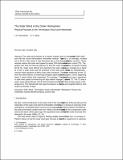The Solar Wind in the Outer Heliosphere: Physical Processes in the Termination Shock and Heliosheath
Author(s)
Stone, E. C.; Richardson, John D.
DownloadRichardson_Solar wind.pdf (1.015Mb)
PUBLISHER_POLICY
Publisher Policy
Article is made available in accordance with the publisher's policy and may be subject to US copyright law. Please refer to the publisher's site for terms of use.
Alternative title
The SolarWind in the Outer Heliosphere
Terms of use
Metadata
Show full item recordAbstract
The solar wind evolves as it moves outward due to interactions with both itself
and with the circum-heliospheric interstellar medium. The speed is, on average, constant out to 30 AU, then starts a slow decrease due to the pickup of interstellar neutrals. These neutrals reduce the solar wind speed by about 20% before the termination shock (TS). The
pickup ions heat the thermal plasma so that the solar wind temperature increases outside 20-30 AU. Solar cycle effects are important; the solar wind pressure changes by a factor of 2 over a solar cycle and the structure of the solar wind is modified by interplanetary coronal mass ejections (ICMEs) near solar maximum. The first direct evidences of the TS were the observations of streaming energetic particles by both Voyagers 1 and 2 beginning about 2 years before their respective TS crossings. The second evidence was a slowdown in solar wind speed commencing 80 days before Voyager 2 crossed the TS. The TS was a weak, quasi-perpendicular shock which transferred the solar wind flow energy mainly to the
pickup ions. The heliosheath has large fluctuations in the plasma and magnetic field on time scales of minutes to days.
Date issued
2008-10Department
MIT Kavli Institute for Astrophysics and Space ResearchJournal
Space Science Reviews
Publisher
Springer Netherlands
Citation
J. Richardson and E. Stone, “The Solar Wind in the Outer Heliosphere,” Space Science Reviews, vol. 143, Mar. 2009, pp. 7-20.
Version: Author's final manuscript
ISSN
0038-6308
1572-9672